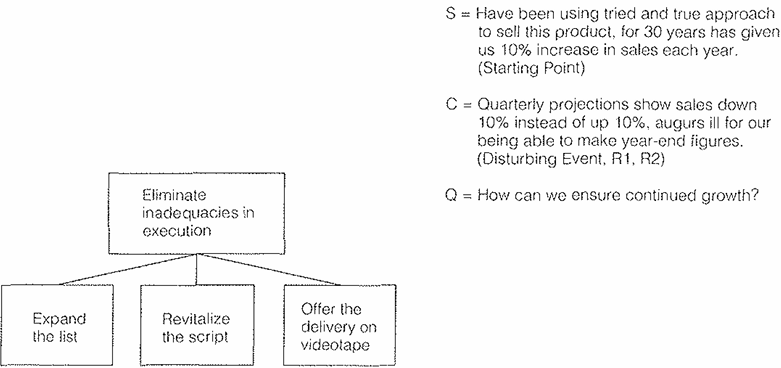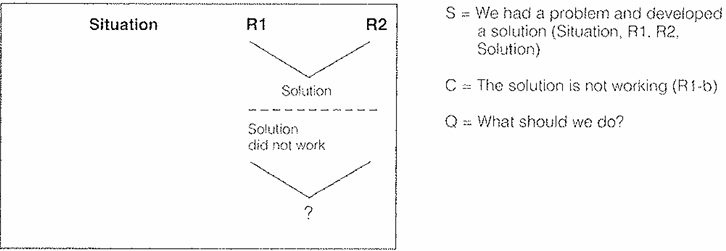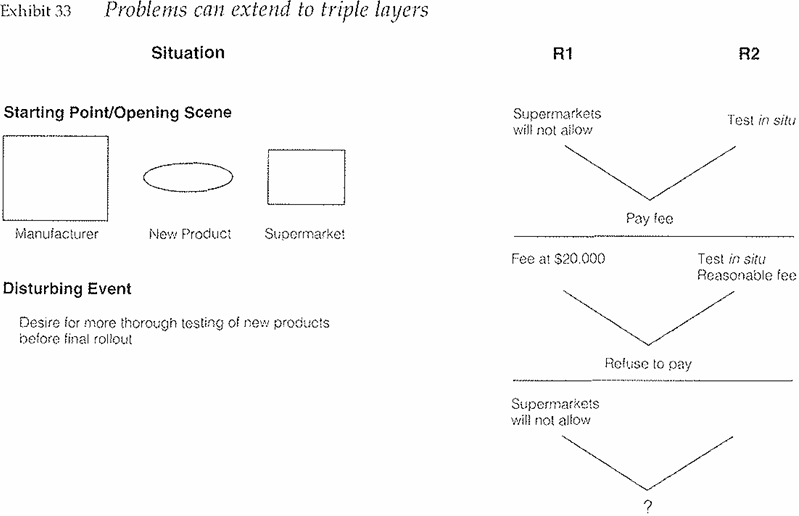
Converting to an Introduction
 المؤلف:
BARBARA MINTO
المؤلف:
BARBARA MINTO
 المصدر:
THE MINTO PYRAMID PRINCIPLE
المصدر:
THE MINTO PYRAMID PRINCIPLE
 الجزء والصفحة:
124-8
الجزء والصفحة:
124-8
 2024-09-16
2024-09-16
 932
932
Converting to an Introduction
Best of all, once you are ready to put the solution in writing, you can easily convert the problem definition to an introduction. You simply read from left to right and down, with the last thing known by the reader always serving as the Complication that triggers the Question. Thus, in this case:

This was, of course, a highly simplified example, in which the question was simply "How do we get from R1 to R2?" worked out in this form:

Most problems have a more complex history. A company could, for example, have identified a problem and already come up with a solution. In that case, the question would be either "Is it the right solution?" or "How do we implement the solution?" And the existence of the solution becomes the Complication that triggers the question.

Or a company could have had a problem, come up with a solution, and found the solution is not working. Then the question is again "What should we do?"

Or you could even have a triple-layer problem, in which the second Solution also did not work. Suppose, for example, you are a large packaged foods manufacturer, back in the days when supermarkets were a fairly new institution. Despite extensive new-product testing, you feel more comfortable testing about-to-be-released products on the supermarket shelves for a week or so before starting the full-scale launch.
You have gone to the supermarkets and announced your intention, but they have balked at allowing you to come in and disrupt their orderly existence. However you have offered to pay a modest fee for the privilege, and they have accepted.
Time passes, supermarkets band into chains, and the fee, as fees have a habit of doing, increases to $20,000 a week, which you think is an outrageous amount of money: A committee is convened to look into the problem but, as committees also have a habit of doing, can agree on no solution other than to refuse to pay. Alas, the supermarkets also refuse to allow week-long test marketing of products on their shelves.
We now have a problem that would be structured to look like Exhibit 33.

This is indeed a complex history But, because you have been able to lay it out and look at it in this orderly way, you can quite easily describe it in a few sentences in the introduction to, say, a speech to members of your industry Again, the technique is to read from left to right and down, making the last thing known by the reader the Complication.
Situation
As you know, in order to overcome the supermarkets' reluctance to permitting week-long testing of new products on their shelves, we in the industry have over the last several years been paying them a fee. This fee has increased every year, so that it now stands at $20,000 somewhat high for a week's use of shelf space. In an effort to make the supermarkets see reason, we have refused to pay the fee. (Situation, R1-a, R2-a, Solution-a, R1-b, R2-b, Solution-b)
Complication
Unfortunately, they have also refused to let us test-market our products. (R1-c)
Question
The question we want to deal with today is how should we respond?
As I said earlier, you use the Problem Definition Framework as the first step in the problem-solving process, as well as the first step in building a pyramid of the ideas that will communicate the solution. You will also find the framework invaluable as an aid to pinpointing and correcting problems in documents passed on to you for review. In either case, the process you want to follow is:
- Lay out the basic parts of the problem as shown in the previous exhibits.
- Identify where you are in terms of the solution. (Has a solution already been suggested or accepted?)
- Determine the appropriate question.
- Check that the introduction reflects the problem definition.
- Check that the pyramid answers the question.
Let me take you through this general process, finishing with a real-life example. Then I will show you how to expand on the problem definition to structure the analysis of the problem and generate possible solutions.
 الاكثر قراءة في Writing
الاكثر قراءة في Writing
 اخر الاخبار
اخر الاخبار
اخبار العتبة العباسية المقدسة


